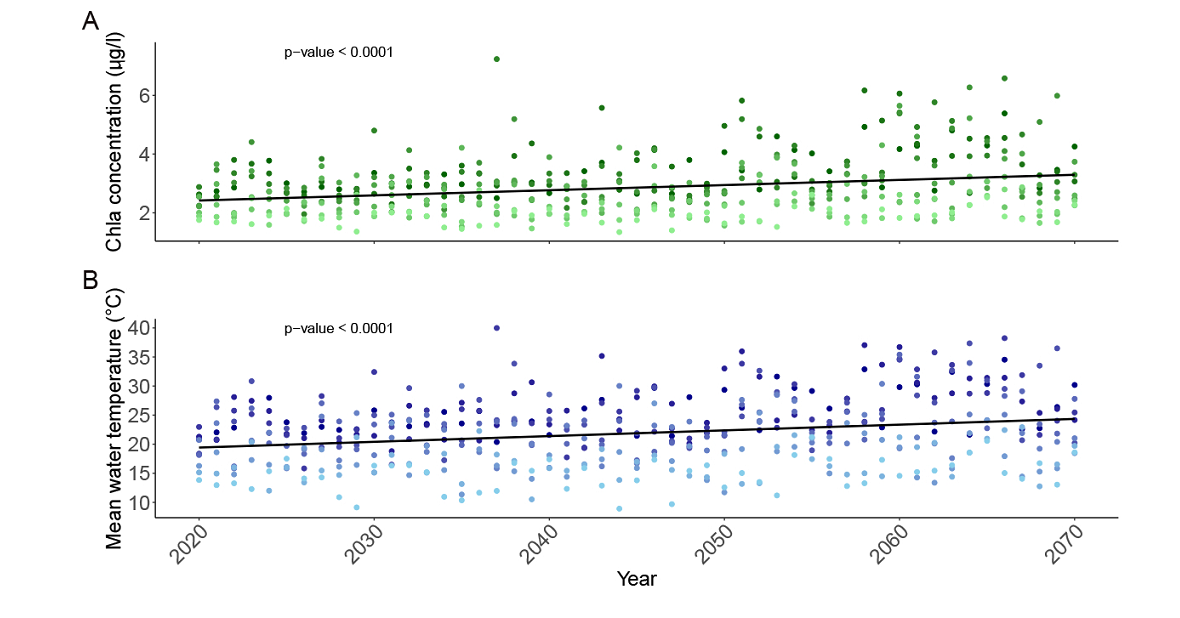Current and anticipated impacts of cyanobacterial blooms and cyanotoxin on various wildlife organisms in Missisquoi bay and the rivière-aux-brochets ecological reserve by 2050
This research project is designed to better understand the dynamics of cyanobacterial blooms and cyanotoxins under climate change. The results will provide a solid foundation for biodiversity conservation through adaptation measures.
Project details
Principal(s) investigator(s)


Context
Missisquoi Bay and the Rivière-aux-Brochets ecological reserve are home to a wide diversity of wild plant and animal species, some of which are legally protected.
Significant cyanobacteria outbreaks and cyanotoxin concentrations in these areas raise concerns about an increase in negative impacts in the short or long term. Observations of water quality in the Missiquoi Bay watershed show that the presence of phosphate alone cannot explain the larger cyanobacterial blooms events.
This project proposes to study whether the impacts of climate change could contribute to the problem of cyanobacteria and cyanotoxins.
Photo credit : Jade Dormoy-Boulanger
Objectifs
-
To study the dynamics of cyanobacteria and their potential consequences on the aquatic food web by analyzing the composition and concentrations of cyanotoxins in water, sediments and fish
-
To assess the impact of climate change on the problem of cyanobacterial proliferation events
-
Assess the impact of temperature and atrazine on phytoplankton species isolated from the Rivière aux Brochets
-
To provide recommendations to the MELCC and MFFP so that they can potentially modify their management and monitoring methods to adapt them to the expected changes
Methodology
-
Bi-monthly monitoring of the abundance of the dominant genera of cyanobacteria and cyanotoxins, total nitrogen and phosphorus, salinity, pH, and winds from July to October in 2018 and 2019 at three sites along the Rivière aux Brochets, plus monitoring on a daily basis for flow, air temperature and precipitation
-
Fish harvesting (71 specimens, 10 species), extraction and assay of fifteen cyanotoxins
-
Laboratory isolation and culture of five phytoplankton species found in the Rivière aux Brochets
-
Conduct a literature review on the main factors influencing the appearance of algal blooms and their toxicity
-
Water temperature modelling and make projections over 50 years
-
Develop a predictive statistical model to estimate the trend in cyanobacterial bloom dynamics for the portion of the river that crosses the Rivière-aux-Brochets ecological reserve, and couple it to the scenario of future water temperature evolution to make 50-year projections.
-
Laboratory evaluation of the photosynthetic efficiency of phytoplankton when water temperature varies and in the presence of herbicides
-
Laboratory toxicity tests of pesticides on zooplankton
Results
The water samples collected from August to October 2018 contained 15 cyanotoxins. In the water, the sum of the concentrations of targeted microcystins reached 1—7 μg L-1 in mid-September and fell below the detection limit by the end of October (<LOD of ~0.05 μg L-1). The sediments collected contained cyanotoxin concentrations in the order of 1.3 ng/kg to 2982 ng/kg. Anabaenopetins A and B were the most abundant, while homoanatoxin-a was present in 8 of the 14 samples and anatoxin-a was found in only one sample. At least one of the cyanotoxins studied was detected in 38% of the fish muscles sampled, and 17% of the samples contained at least one microcystin.
The composition of cyanobacteria in the Rivière aux Brochets varies greatly over time and between sites. The climate scenarios associated with the largest increase in greenhouse gas concentrations (RCP 8.5) project a significant increase in cyanobacterial biomass by 2050 compared to 2018-2019. On average, we estimate that the concentration of chlorophyll a, and therefore the cyanobacterial biomass, could increase by a maximum of 30% over the next 50 years in the Rivière aux Brochets. The researchers caution, however, that these are conservative estimates of the potential impacts of climate change on algal dynamics, as the years covered by the study were not marked by impressive cyanobacterial blooms in the Rivière aux Brochets compared with previous years.

Figure 1 : Seasonal and annual projections of chla concentration (A) for the next 50 years based on a climate scenario associated with RCP 8.5 and using projected temperature variations (B). Darker dots represent midsummer (late July/early August) and lighter dots represent autumn (late October).
In the three species isolated (a green alga and two cyanobacteria: Chlamydomonas globosa, Dolichospermum flos-aquae and Microcystis aeruginosa), when day-night variation is induced at growth temperature, photosynthesis is generally not greatly affected. However, the different temperature scenarios studied influence the toxicity of atrazine (a herbicide frequently found in waterways in agricultural regions, such as the Rivière aux Brochets). This indicates that the presence of atrazine could promote the dominance of M. aeruginosa in a natural agricultural environment when day/night temperature variations occur.
Benefits for adaptation
Benefits for adaptation
The model on the changes in water temperature developed as part of this project is a step toward predicting the effects of climate change on phytoplankton proliferation.
The project has led to a number of recommendations to the MELCC and MFFP to adjust their management and monitoring methods for cyanobacteria and cyanotoxins in light of the expected changes. These recommendations are for example to : include analysis of cyanotoxin accumulation in fish and sediments and non-specific analyses using high-resolution mass spectrometry techniques in monitoring efforts ; review water quality criteria for various contaminants by considering average water temperature and its variations.
Scientific publications
Funding





Other participants
-
Ministère de l’Environnement et de la Lutte contre les changements climatiques (MELCC)
-
Ministère des Forêts, de la Faune et des Parcs (MFFP)
-
ATRAPP (Prévision, prévention et traitement des proliférations d'algues et évaluation des risques y afférents grâce à la génomique)
-
Conseil national de recherches Canada
Related projects
554029